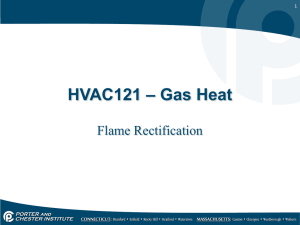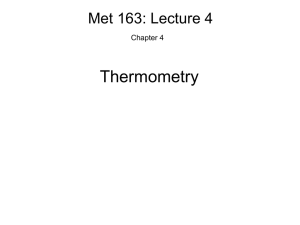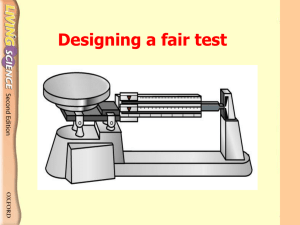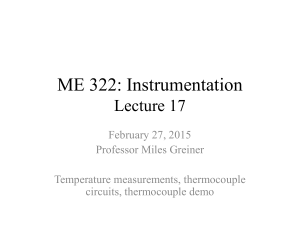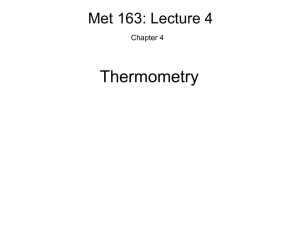Thermocouple-Induced Perturbations of the Flame Structure P.A.
advertisement
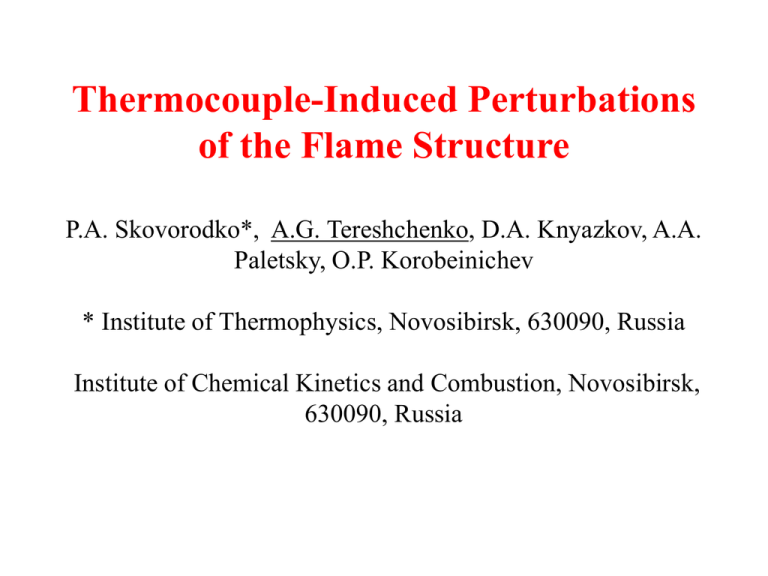
Thermocouple-Induced Perturbations of the Flame Structure P.A. Skovorodko*, A.G. Tereshchenko, D.A. Knyazkov, A.A. Paletsky, O.P. Korobeinichev * Institute of Thermophysics, Novosibirsk, 630090, Russia Institute of Chemical Kinetics and Combustion, Novosibirsk, 630090, Russia Background • Measuring flame thermal structure with appropriate accuracy is one of the most important problems in combustion research. • Thermocouples are the most convenient and simple tool for temperature measurements in flames of gas and condensed systems. Accuracy of thermocouple measurements • It is well known that the accuracy of the thermocouple measurements in the flame zone with high temperature gradient is mainly influenced by the following factors: (1) the thickness of thermocouple, which leads to averaging the temperature in the space occupied by the thermocouple, (2) heat losses into the ends of the thermocouple and (3) radiation heat losses at temperatures higher than 1000 К. • Taking into account the above mentioned factors, accuracy of thermocouple measurements in the flames declared in the majority of studies is about of ± 30-50 К. Motivation • In our laboratory, for many years temperature profiles in one-dimensional burner-stabilized premixed flames at atmospheric pressure have been measured by thermocouples and calculated using the PREMIX code from the CHEMKIN II package with the application of a detailed mechanism of chemical reactions for each flame. It was found out that the temperature distributions in the flames, obtained by thermocouples, exceeded calculated values in the area with temperature gradient and in the zone of maximum concentration of radicals. 2000 T, K Fig. 1. The methan flame. 1–Т* experiment. (Pt/Pt+10%Rh with layer of SiO2, circular 30 μm). 2 - ТСН4 – расчёт. 1750 1500 1 1250 2 1000 2 750 500 250 0 0.0 0.5 1.0 1.5 Distance from burner, mm 2.0 The first zone from 0.1 to 0.5 mm. The second zone from 0.6 to 2 mm Effect investigated. From 0.1 to 0.5 mm • Circular and ribbon thermocouples present a certain obstacle for the gas flow. It is usually assumed that, due to a small size, the thermocouple produces negligible perturbations of the flame structure. We found out that the influence of this effect can be significant. In the case of large mass flows in the flame, which take place in combustion of condensed systems, this effect becomes very significant. • Goal of the work. • To study the disturbances of gas flow, caused by presence of the thermocouples in the flame, and to define how these disturbances influence on the results of thermocouple measurements. This effect was studied both experimentally and numerically in the gas flame at a pressure of 1 atm, and purely numerically for the combustion of a condensed fuel at pressure 20 atm. Experimental Technique • We studied the temperature profile in premixed methane/oxygen/argon (CH4/O2/Ar – 6/15/79 vol. %) flame stabilized on a flat burner at atmospheric pressure. • The burner top was a porous brass disk 16 mm in diameter and 5 mm high. It was made of sintered spheres ~0.1 mm in diameter. The relative porosity of the burner disk was ~ 40%. The surface temperature of the burner was kept at 368 K. The flow rate of the unburned mixture was 25 cm3/s. Temperature profiles were measured using three types of Pt/Pt+10%Rh thermocouples coated with a thin layer of SiO2 (~ 2–3 μm). One of the thermocouples (TC1) had a circular cross section with a diameter of about 24 μm. The other two thermocouples had rectangular cross sections, and their dimensions were 10x110 μm (TC2) and 20x125 μm (TC3). The error of the thermocouple measurements was within ±30 К. Experimental uncertainty is determined from the scatter of experimental data of 4–5 temperature profiles. Thermocouple was located in parallel to the surface of the burner Photographs of thermocouples TP1circular а) Workingучасток section TP2-3 Рабочий ТП2-3 б) TP2 and TP3 ribbons Ò, Ê 1800 1600 1400 1200 1 1000 2 800 600 0.0 0.2 0.4 0.6 0.8 1.0 1.2 1.4 Distance from burner, mm Fig.4. • Temperature profiles in the methane flame. 1- primary experimental data: ТTC1 profiles without correction for radiation heat losses. • 2- Tup (unperturbed flame, PREMIX), Ò, K 1800 • Fig.5. • Temperature profiles in the methane flame. 1- primary experimental data: ТTC3 profiles without correction for radiation heat losses. 1600 1400 1200 1 1000 800 2 600 0.0 0.2 0.4 0.6 0.8 1.0 Distance from burner, mm 1.2 2- Tup (unperturbed flame, PREMIX), Ò, Ê 2000 1800 1600 1400 1200 1000 800 600 400 200 2 3 1 1400 2 1200 1 1000 0,5 4 800 4 0,0 3 0,2 1,0 1,5 0,3 2,0 Distance from burner, mm 0,4 2,5 3,0 Fig. 6. Temperature profiles in the methane flame. Curves 1, 2, and 3: smoothed experimental temperature profiles with correction for radiation heat losses, 1 - ТTC1, 2 - ТTC2, 3 - ТTC3. Curve 4 - Тup, 300 • Fig. 7. • Curves 1, 2, and 3: thermocouplemeasured temperature elevation above the unperturbed flame temperature. 250 2 200 150 100 50 2 1 3 0 0.0 0.5 1.0 1.5 2.0 2.5 3.0 • • • 1 – ΔТ = T*ТC1 - ТСН4, 2 – ΔТ = Т*ТC2 - ТСН4, 3 – ΔТ = Т*ТC3 - ТСН4. Distance from burner, mm Exceedings at a distance of 0.2 mm reach the values of 130 -150 K, which is considerably higher than the accuracy of measurements (±30K). Numerical Simulation of the Flow • The plane external flow field over a thermocouple inserted in the flow at some distance from the burner was simulated using the full set of unsteady Navier–Stokes equations. A finite-difference representation of the governing equations was made on a staggered grid, which allowed the development of an effective algorithm for simulating viscous flows. An approximate allowance for the heat release due to chemical reactions was made by adding a source term to the energy equation to provide a given temperature distribution in the plane unperturbed isobaric flame, i. e., with no thermocouple in the flame. The simulation domain was a rectangle with dimensions of 2.4 mm in the longitudinal direction (x) and 1.5 mm in the transverse direction (y) with mesh sizes of the grid dx = dy = 2.5 m. The initial distribution of the parameters in the simulation domain was assumed to be the same as in the undisturbed flame. • In the presence of the thermocouple, this distribution is violated due to the presence of solid surfaces in the flow field and heat transfer between the gas and the thermocouple surface. As a result, the flow begins to change, and after some time, it reaches a steady state. Calculations were performed in connection with the flame of methane, which was used in our experiments, and also to the flame of hexogen at a pressure 20 atm. • The heat release was assigned with the aid of the onedimensional fixed sources, or with the aid of the source term which value was determined by the local temperature in the flow. The latter approach seems to be more adequate from the point of view of the description of the nonlinear effects of the mutual influence of chemical and gas dynamic processes. The temperature distribution in the undisturbed flame is reproduced well within the framework any of these two approaches. Temperature deviation in the flame of methane at a pressure 1 atmosphere T-Tup, K Fig. 8. Deviation numerical 200 1 100 (curves 1 – 4) and experimental (curve 5) temperature profiles from unperturbed data 2 0 3 -100 1 - Q(T), = 0; 5 2 - Q(x), = 0; -200 3 - Q(T), = (T); 4 4 - Q(x), = (T); -300 0,0 of 0,5 1,0 1,5 Distance from burner, mm 2,0 5 – TTC3 – Tup. ε – actual emissivity of the thermocouple. T(0) - T(), K 250 4 200 2 3 150 1 100 50 0 0,0 0,5 1,0 1,5 Distance from burner, mm • Fig. 9. Data for heat losses from thermocouple TC3 due to radiation. Numerical (curves 1, 2), and semiempirical (curves 3, 4) • 1 - model with Q(T), • 2 - model with Q(x), 2,0 • 3 – [Kaskan], • 4 – [Wong]. 40 30 400 200 0 0 200 10 20 20 y,m 50 60 70 600 400 600 Distance from burner, m • Fig. 10. Longitudinal velocity field (cm/s) for flow around thermocouple TC3 predicted by the model with Q(T) and = 0. • Fig. 11. Isotherm field (K) for the same conditions as in Fig. 10. 1500 1200 900 400 600 y, m 600 200 0 0 200 400 Distance from burner, 600 m Essence of the effect • Thermocouple forms the deceleration zone and at the same time it reflects the temperature in this perturbed zone. Since the thermocouple stands in the gas flow with the intensive heat release due to the chemical reactions, in the region of the thermocouple position is disrupted the balance between heat release and removal of heat due to the draining of products from the burning surface, and also due to thermal conductivity. The disturbance of this balance, typical of the undisturbed flame, leads to the field distortion of isotherms in the vicinity of the thermocouple. The second zone of overheating at a distance from 0.6 to 2 mm 2000 T, K Fig. 1. The methan flame. 1–Т* experiment. (Pt/Pt+10%Rh with layer of SiO2, circular 30 μm). 2 - ТСН4 – расчёт. 1750 1500 1 1250 2 1000 2 750 500 250 0 0.0 0.5 1.0 1.5 Distance from burner, mm 2.0 The first zone from 0.1 to 0.5 mm. The second zone from 0.6 to 2 mm Comparison of the zone of radicals with the second region of overheating thermocouple o l e f r a c t i o n M 5 0 0 0 , 0 0 3 Fig. 12. Elevation thermocouple4 0 0 measured temperature Î Í 0 , 0 0 2 above the unperturbed 3 0 0 flame temperature Í (curves 1, 2, and 3) and Н and ОН are radical 2 0 0 0 , 0 0 1 concentration profiles 2 in the unperturbed 1 0 0 3 flame. 1 2 0 0 , 0 0 0 1 - (TTC1- Tup ), 2 - (ТTC2 – Тup), 0 , 0 0 , 5 1 , 0 1 , 5 2 , 0 2 , 5 3 , 0 3 - (TTC3-Tup). D i s t a n c e f r o m b u r n e r , m m The effect of radical recombination on the surface of quartz film on the thermocouple • The number of radical collisions (N) per unit thermocouple surface per unit time was calculated from the H and OH concentration profiles. The heat flux to the thermocouple was obtained using the known values of heat release (Н*) in a single recombination event on the surface. A similar approach to accounting for heat release on the thermocouple surface due to the recombination of H radicals on this surface. The heat flux data were transformed to temperature data by the procedure used above to calculate the radiation correction: • T = Tc - Tg = [1.25d3/4 К·N·Н*·(/v)1/4]/ , • where К - is probability of radical recombination. In order that the observed second maximum of the temperature elevation may be explained by the radical recombination effect on the thermocouple surface, the probability of recombination per collision must be in the range from 10-3 to 10-2, which seems quite realistic [Rubtsov and other J. Physical Chem. A, 2009, T. 83, № 10, pp. 1701-1704] for the anticatalytic SiO2 layer used. Protection of the thermocouple by anti-catalytic coating • • Despite the fact that thermocouple is covered with the anti-catalytic layer SiO2, due to the recombination of the radicals of flame on the surface of treatment, in the region of the maximum of the concentration of radicals the significant quantity of heat, which influences the indications of thermocouple, can be separated. Anti-catalytic coating does not guarantee 100% of protection of thermocouple from the catalytic reactions on its surface. Depending on the type of coating, some catalytic effect with the heat emission on the surface of thermocouple can occur and in each specific case this must be borne in mind. RDX flame at 20 atm • Disturbances of thermal structure of the flame with high mass flow rate, which is typical for combustion of CF at elevated pressure. To study the influence of thermocouple shape on the temperature profile, a flame of hexogen at 20 atm with the mass flow of 0.83 g/cm2·s [ Zenin, J. Prop. Pow., 1995, v.11, N.4, p.752-758] was selected. Temperature profile in this flame was considered as undisturbed (TRDX). The effect of disturbance by the thermocouple of the flow structure, in which it is located, was studied for the thermocouples of two forms: ribbon, with a cross-section of 3x60 μm - TP4, which was used in the work of Zenin, and that close to square shape with a cross-section of 13x14 μm - TP5, which in some approximation imitated round thermocouple. Т, T, К • Fig. 13. Temperature profiles in the flame of hexogen calculated for two thermocouples of various forms with similar crosssection. 1- TRDX; 2Q (T), 3- Q (x) for TTP4 (3×60 μm ); 4- Q (T) for TTP5 (13×14 μm); 5-7 - ∆T2-4, respectively. 3000 3 2500 4 2000 1 1500 1000 2 5 500 6 7 0 0 10 20 30 40 Distance from burner, m 50 60 Vortex in the region after the thermocouple Y, m 100 80 60 40 20 0 0 20 40 60 80 Distance from burner, m 100 Fig.14. Field of isotherms (K) in the RDX flame for the thermocoupe with a crosssection of 3x60 μm. 2400 120 2100 2400 1800 1500 60 1200 900 30 2700 Y, m 90 0 0 10 20 30 40 50 Distance from burner, m 60 • Fig.15. Field of isotherms (K) in the RDX flame for the thermocouple with a crosssection of 3x60 μm. Conclusions • • • 1. The temperature profiles in the methane flame measured by thermocouples of that covered with the anti-catalytic coating (film SIO2) were found to be higher than the profile calculated by Chemkin in the unperturbed flame in the region with a high temperature gradient and in the region with maximum concentrations of H and OH radicals. 2. The simulation of the arrangement of thermocouple in the flame in the region of temperature gradient also confirmed the presence of the effect of overheating thermocouple in this zone of flame. This overheating can lead to an increase in the measured by thermocouple gradient in comparison with its value in the undisturbed flame. 3. Deceleration of the flow of the reacting gases in the environment of the thermocouple in the region of temperature gradient leads to a local increase in the heat release as a result of the chemical reactions and the corresponding increase in the temperature of thermocouple relative to unperturbed values. Conclusions • • • 4. The magnitude of effect of overheating grows with an increase of the mass flow rate of gas in the flame and the width of thermocouple. Ribbon thermocouples lead to the more essential overstating of the measured temperature, than round with the same cross-sectional area of the thermocouple. 5. At a pressure of 20 atmospheres the model of the disturbed flow of the products of combustion of hexogen near the thermocouple predicts overstating 1.5 - 2 times of the gradient of the measured temperature in comparison with the same in the undisturbed flame. There are foundations for assuming that the value of this overstating will be grow with an increase of the pressure. 6. The developed model of perturbed flow around a thermocouple predicts more intense heat transfer between the thermocouple and chemically nonequilibrium reactive flow compared to the same process in chemically inert flow (air). Thanks for the attention! If you have please, questions concerning the report.

